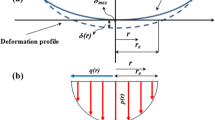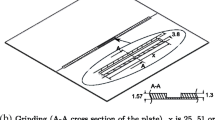Abstract
The static-implicit finite element method was used to simulate the low plasticity ball burnishing process using two-dimensional (2-D) and three-dimensional (3-D) models. The simulations were performed using an elastic-rigid strain hardening plastic flow model. The residual stress distribution along the surface layer of the Ti6Al4V thin sheet is predicted, and the results are compared with limited experimental data from the industry. The simulated residual stresses matched with the measured ones in terms of trends; however, some deviations were observed for the peak and boundary values. The 2-D model is practical to construct, and the simulations are fast; however, it does not provide the planar stress distribution. The 3-D model is more realistic, yet still very sensitive to boundary conditions as well as friction. More realistic results are possible with large models where the effects of boundary conditions get weaker.

















Similar content being viewed by others
References
Bozdana AT (2005) On the mechanical surface enhancement techniques in aerospace industry a review of technology. Aircr Eng Aerosp Technol 77:279–292
Prevéy PS, Shepard MJ, Smith PR, (2001) The effect of low plasticity burnishing (LPB) on HCF performance and FOD resistance of Ti6Al4V, Proc. of the 6th National Turbine Engine HCF Conf., Jacksonville, FL USA
Prevéy PS, Ravindranath RA, Shepard M, Gabb T (2003) Case studies of fatigue life improvement using low plasticity burnishing in gas turbine engine applications, Proceedings of ASME Turbo Expo, June 16–19, 2003, Atlanta, Georgia, USA.
Avilés R, Albizuri J, Rodríguez A, López de Lacalle LN (2013) Influence of low-plasticity ball burnishing on the high-cycle fatigue strength of medium carbon AISI 1045 steel, Int. J Fatigue 55:230–244
Luca L, Neagu-Ventzel S, Marinescu I (2005) Effects of working parameters on surface finish in ball-burnishing of hardened steels. Precis Eng 29:253–256
Buldum BB, Çağan SÇ (2017) The optimization of surface roughness of AZ91D magnesium alloy using ANOVA in ball burnishing process. Turk J Eng 1–1:25–31. https://doi.org/10.31127/tuje.316860
Swirad S, Wdowik R (2019) Determining the effect of ball burnishing parameters on surface roughness using the Taguchi method. Procedia Manuf 34:287–292. https://doi.org/10.1016/j.promfg.2019.06.152
Talwar G (2015) Surface roughness, hardness and microstructure characterization of cold rolled sheet. M.Sc Thesis, Thapar Univ. Patiala, India
Prevéy PS, Jayaraman N, Ravindranath R (2003) Low plasticity burnishing (LPB) treatment to mitigate FOD and corrosion fatigue damage In 17-4 PH Stainless Steel, Proc. of the Tri-Service Corrosion Conference November 17-21, 2003 Las Vegas, NV, USA, pp 1–11
Zhang T, Bugtai N, Marinescu ID (2015) Burnishing of aerospace alloy: a theoretical-experimental approach. J Manuf Syst 37:472–478. https://doi.org/10.1016/j.jmsy.2014.11.004
Okada M, Shinya M, Matsubara H, Kozuka H, Tachiya H, Asakawa N, Otsu M (2017) Development and characterization of diamond tip burnishing with a rotary tool. J Mater Process Technol 244:106–115. https://doi.org/10.1016/j.jmatprotec.2017.01.020
Chomienne V, Valiorgue F, Rech J, Verdu C (2016) Influence of ball burnishing on residual stress profile of a 15-5PH stainless steel. CIRP J Manuf Sci Technol 13:90–96
Migala TS, Jacobs TL (2003) Low plasticity burnishing: an affordable, effective means of surface enhancement. Proc. of the 1st ASM International Surface Engineering and the 13th IFHTSE Congress Jan. 01, 2003. ASM International, USA
Ecoroll (2006) www.ecoroll.de
Neagu-Ventzel S (2001) A theoretical and experimental study of single-roll burnishing process, as applied yokes. Ph.D. Thesis, University of Toledo, USA
Luca L (2002) Investigations into the ball-burnishing of hardened steel components as a finishing process. Ph.D Thesis, University of Toledo, USA
Altan T, Yen YC, Sartkulvanich P (2004) Finite element modeling of roller burnishing process. Tech. Report., ERC/NSM (currently CPF at the Ohio State Un.), Ohio, USA
Hiegemann L, Weddeling C, Tekkaya E (2016) Analytical contact pressure model for predicting roughness of ball burnished surfaces. J Mater Process Technol 232:63–77
GE (2006) GE Manufacturing and Quality Technologies Department Evansdale, OH, USA
Yu H, Yan M, Li J, Godbole A, Lu C, Tieu K, Kong C (2018) Mechanical properties and microstructure of a Ti-6Al-4V alloy subjected to cold rolling, asymmetric rolling, and asymmetric cryorolling. Mater Sci Eng A 710:10–16. https://doi.org/10.1016/j.msea.2017.10.075
Shaw LL, Tian JW, Ortiz AL, Dai K, Villegas JC, Liaw PK, Ren R, Klarstrom DL (2010) A direct comparison in the fatigue resistance enhanced by surface severe plastic deformation and shot peening in a C-2000 superalloy. Mater Sci Eng A 527(4–5):986–994. https://doi.org/10.1016/j.msea.2009.10.028
Malleswara Rao JN, Reddy CK et al (2011) Finite element approach for the prediction of residual stresses in aluminum work-pieces produced by roller burnishing. Int J Des Manuf Technol 2-1:07–20
Lu J (ed) (1996) Handbook of measurement of residual stresses. Society for Experimental Mechanics, Inc. Fairmont Press, Upper Saddle River
Acknowledgments
Many thanks are owed to General Electric Marmara Technology Center Ltd. (GEMTC) for providing the experimental data presented in this paper. The results presented in this article have also been summarized from E. Has’s Master’s Thesis conducted at Istanbul Technical University Department of Mechanical Engineering.
Author information
Authors and Affiliations
Corresponding author
Additional information
Publisher’s note
Springer Nature remains neutral with regard to jurisdictional claims in published maps and institutional affiliations.
Rights and permissions
About this article
Cite this article
Livatyali, H., Has, E. & Türköz, M. Prediction of residual stresses in ball burnishing TI6AL4V thin sheets. Int J Adv Manuf Technol 110, 1083–1093 (2020). https://doi.org/10.1007/s00170-020-05837-2
Received:
Accepted:
Published:
Issue Date:
DOI: https://doi.org/10.1007/s00170-020-05837-2




